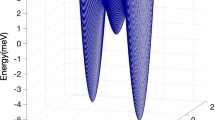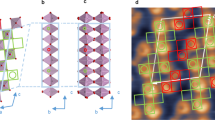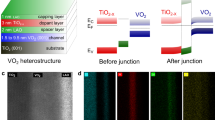Abstract
The study of metal–insulator transitions (MITs) in crystalline solids is a subject of paramount importance, both from the fundamental point of view and for its relevance to the transport properties of materials. Recently, a MIT governed by disorder was observed in crystalline phase-change materials. Here we report on calculations employing density functional theory, which identify the microscopic mechanism that localizes the wavefunctions and is driving this transition. We show that, in the insulating phase, the electronic states responsible for charge transport are localized inside regions having large vacancy concentrations. The transition to the metallic state is driven by the dissolution of these vacancy clusters and the formation of ordered vacancy layers. These results provide important insights on controlling the wavefunction localization, which should help to develop conceptually new devices based on multiple resistance states.
This is a preview of subscription content, access via your institution
Access options
Subscribe to this journal
Receive 12 print issues and online access
$259.00 per year
only $21.58 per issue
Buy this article
- Purchase on Springer Link
- Instant access to full article PDF
Prices may be subject to local taxes which are calculated during checkout



Similar content being viewed by others
References
Anderson, P. W. Absence of diffusion in certain random lattices. Phys. Rev. 109, 1492–1505 (1958).
Mott, N. F. Conduction in glasses containing transition metal ions. J. Non-Cryst. Solids 1, 1–17 (1968).
Alexander, M. N. & Holcomb, D. F. Semiconductor-to-metal transition in n-type group IV semiconductors. Rev. Mod. Phys. 40, 815–829 (1968).
Rosenbaum, T. F., Andres, K., Thomas, G. A. & Bhatt, R. N. Sharp insulator transition in a random solid. Phys. Rev. Lett. 45, 1723–1726 (1980).
Gaymann, A., Geserich, H. P. & Löhneysen, H. V. Temperature dependence of the far-infrared reflectance spectra of Si:P near the metal–insulator transition. Phys. Rev. B 52, 16486–16493 (1995).
Kramer, B. & MacKinnon, A. Localization: Theory and experiment. Rep. Prog. Phys. 56, 1469–1564 (1993).
Abrahams, E., Anderson, P. W., Licciardello, D. C. & Ramakrishnan, T. V. Scaling theory of localization: Absence of quantum diffusion in two dimensions. Phys. Rev. Lett. 42, 673–676 (1979).
Wegner, F. The mobility edge problem: Continuous symmetry and a conjecture. Z. Phys. B 35, 207–210 (1979).
Shklovskii, B. I. & Efros, A. L. Electronic Properties of Doped Semiconductors (Springer, 1984).
Efetov, K. B. Supersymmetry in Disorder and Chaos (Cambridge Univ. Press, 1997).
Hubbard, J. Electron correlations in narrow energy bands. Proc. R. Soc. Lond. A 276, 238–257 (1963).
Georges, A. & Kotliar, G. Hubbard model in infinite dimensions. Phys. Rev. B 45, 6479–6483 (1992).
Kotliar, G. et al. Electronic structure calculations with dynamical mean-field theory. Rev. Mod. Phys. 78, 865–951 (2006).
Dong, J. & Drabold, D. A. Atomistic structure of band-tail states in amorphous silicon. Phys. Rev. Lett. 80, 1928–1931 (1998).
Siegrist, T. et al. Disorder-induced localization in crystalline phase-change materials. Nature Mater. 10, 202–208 (2011).
Shportko, K. et al. Resonant bonding in crystalline phase-change materials. Nature Mater. 7, 653–658 (2008).
Lencer, D. et al. A map for phase-change materials. Nature Mater. 7, 972–977 (2008).
Peierls, R. E. Quantum Theory of Solids (Oxford Univ. Press, 1956).
Wuttig, M. et al. The role of vacancies and local distortions in the design of new phase-change materials. Nature Mater. 6, 122–128 (2007).
Wuttig, M. & Yamada, N. Phase-change materials for rewriteable data storage. Nature Mater. 6, 824–832 (2007).
Korringa, J. On the calculation of the energy of a Bloch wave in a metal. Physica 13, 392–400 (1947).
Kohn, W. & Rostoker, N. Solution of the Schrödinger equation in periodic lattices with an application to metallic Lithium. Phys. Rev. 94, 1111–1120 (1954).
Raoux, S. & Wuttig, M. (eds) Phase Change Materials: Science and Applications (Springer, 2008).
Yamada, N. & Matsunaga, T. Structure of laser-crystallized Ge2Sb2+xTe5 sputtered thin films for use in optical memory. J. Appl. Phys. 88, 7020–7028 (2000).
Wełnic, W. et al. Unravelling the interplay of local structure and physical properties in phase-change materials. Nature Mater. 5, 56–62 (2005).
Kooi, B. J. & De Hosson, T. M. J. Electron diffraction and high-resolution transmission electron microscopy of the high temperature crystal structures of GexSb2Te3+x (x = 1,2,3) phase change material. J. Appl. Phys. 92, 3584–3590 (2002).
Matsunaga, T. & Yamada, N. Structural investigation of GeSb2Te4: A high-speed phase-change material. Phys. Rev. B 69, 104111 (2004).
Lee, B-S. et al. Investigation of the optical and electronic properties of Ge2Sb2Te5 phase change material in its amorphous, cubic, and hexagonal phases. J. Appl. Phys. 97, 093509 (2005).
Thiess, A., Zeller, R., Bolten, M., Dederichs, P. H. & Blügel, S. Massively parallel density functional calculations for thousands of atoms: KKRnano. Phys. Rev. B 85, 235103 (2012).
Von Barth, U. & Hedin, L. A local exchange-correlation potential for the spin polarized case: I. J. Phys. C 5, 1629–1642 (1972).
VandeVondele, J. et al. QUICKSTEP: Fast and accurate density functional calculations using a mixed Gaussian and plane waves approach. Comput. Phys. Commun. 167, 103–128 (2005).
Krack, M. & Parrinello, M. in High Performance Computing in Chemistry Vol. 25 (ed. Grotendorst, J.) 29–51 (NIC, http://cp2k.berlios.de2004).
Goedecker, S., Teter, M. & Hutter, J. Separable dual-space Gaussian pseudopotentials. Phys. Rev. B 54, 1703–1710 (1996).
Perdew, J. P., Burke, K. & Ernzerhof, M. Generalized gradient approximation made simple. Phys. Rev. Lett. 77, 3865–3868 (1996).
Acknowledgements
We thank S. Caravati and Y. Li for useful discussions. We gratefully acknowledge funding by the DFG (German Science Foundation) within the collaborative research centre SFB 917 ‘Nanoswitches’, as well as the computational resources by the RWTH Rechenzentrum and the Forschungszentrum Jülich.
Author information
Authors and Affiliations
Contributions
W.Z. and A.T. performed the CP2K and KKRNano simulations respectively. Analysis of the data was mostly carried out by W.Z., P.Z. and R.M. (CP2K) and A.T., R.Z. and P.H.D. (KKRnano). The paper was written by R.M. and M.W., with help from all co-authors, in particular W.Z. and A.T. The project was initiated and conceptualized by S.B., R.M. and M.W.
Corresponding authors
Ethics declarations
Competing interests
The authors declare no competing financial interests.
Supplementary information
Supplementary Information
Supplementary Information (PDF 2132 kb)
Rights and permissions
About this article
Cite this article
Zhang, W., Thiess, A., Zalden, P. et al. Role of vacancies in metal–insulator transitions of crystalline phase-change materials. Nature Mater 11, 952–956 (2012). https://doi.org/10.1038/nmat3456
Received:
Accepted:
Published:
Issue Date:
DOI: https://doi.org/10.1038/nmat3456
This article is cited by
-
Device-scale atomistic modelling of phase-change memory materials
Nature Electronics (2023)
-
Multiscale simulations of growth-dominated Sb2Te phase-change material for non-volatile photonic applications
npj Computational Materials (2023)
-
Real-time nanomechanical property modulation as a framework for tunable NEMS
Nature Communications (2022)
-
The “gene” of reversible phase transformation of phase change materials: Octahedral motif
Nano Research (2022)
-
Interface controlled thermal resistances of ultra-thin chalcogenide-based phase change memory devices
Nature Communications (2021)



